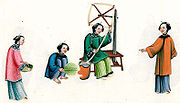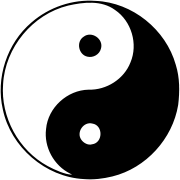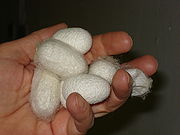
Silk reeling
Encyclopedia

Neigong
Neigong, also spelled nei kung, neigung, or nae gong, refers to any of a set of Chinese breathing, meditation and spiritual practice disciplines associated with Daoism and especially the Chinese martial arts...
movement principles expressed in traditional styles of t'ai chi ch'uan, but especially emphasised by the Chen and Wu style
Wu style tai chi chuan
The Wu family-style t'ai chi ch'uan of Wu Ch'uan-yu and Wu Chien-ch'uan is the second most popular form of t'ai chi ch'uan in the world today, after the Yang style, and fourth in terms of family seniority. This style is different from the Wu style of t'ai chi ch'uan founded by Wu Yu-hsiang...
s of t'ai chi ch'uan. The name derives from the metaphorical principle of "reeling the silk
Silk
Silk is a natural protein fiber, some forms of which can be woven into textiles. The best-known type of silk is obtained from the cocoons of the larvae of the mulberry silkworm Bombyx mori reared in captivity...
from a silk worm's cocoon". In order to draw out the silk successfully the action must be smooth and consistent without jerking or changing direction sharply. Too fast, the silk breaks, too slow, it sticks to itself and becomes tangled. Hence, the silk reeling movements are continuous, cyclic patterns performed at constant speed with the "light touch" of drawing silk. Silk reeling is trained in solo forms and stances as well as in pushing hands
Pushing hands
Pushing hands, , is a name for two-person training routines practiced in internal Chinese martial arts such as Baguazhang, Xingyiquan, T'ai chi ch'uan , Liuhebafa, Quan Fa, Yiquan.-Overview:...
with a partner.
As described by Wu Kung-tsao
Wu Kung-tsao
Wu Kung-tsao was a famous Chinese teacher of t'ai chi ch'uan. He taught in Beijing, Shanghai, Changsha and Hong Kong. The second son of Wu Chien-ch'üan, he was the grandson of the first teacher of Wu style T'ai Chi Ch'uan, Wu Ch'uan-yü. Wu Kung-tsao was the younger brother of Wu Kung-i and the...
:
This resembles the strands of spun silk. Winding silk energy is applied in pushing hands when opponents probe, use locking maneuversChin NaChin Na or Qinna is a Chinese term describing techniques used in the Chinese martial arts that control or lock an opponent's joints or muscles/tendons so he cannot move, thus neutralizing the opponent's fighting ability...
, neutralize, vie for control, and practice tactical movements around each other's space.There are six methods of winding silk energy: inner, outer, upper, lower, forward and backward. They are applied from anywhere on the body: the arms, legs, hips and waist, with the body moving continuously, with endless circularity, wrapped together like intertwined filaments of silk.
...
One who is skilled at winding silk energy is keenly sensitive and can accurately probe and stay with the opponent as he extends and contracts.
Chen-style silk reeling movements originate from the dantian
Dantian
Dantian, dan t'ian, dan tien or tan t'ien is loosely translated as "elixir field". It is described as an important focal point for internal meditative techniques.There are various points of dantian...
and trace a taijitu
Taijitu
Taijitu is a term which refers to a Chinese symbol for the concept of yin and yang...
pattern. Starting first with the outside circle and then adding the "tear shapes" (to quickly change direction while maintaining a smooth motion) while shifting the weight from leg to leg; this motion in turn drives the rest of the joints of the body in a fluid, spiraling motion.


- Single Arm - Front Circle (zhengmian) (Left and Right Side)
- Double Arm - Front Circle
- Single Arm - Side Circle (cemian) (Left and Right Side)
- Double Arm - Side Circle
- Peng-Lu (Left and Right Side)
- Peng-Lu-Ji-An Reeling Silk (Left and Right Side)
Once these are learnt and understood footwork (Bu fa) is added including: side stepping, diagonal stepping, forwards and backwards stepping:
- Single arm side stepping - Front Circle (zhengmian) (Left and Right Side)
- Diagonal stepping (Shaung – Lu) (Left and Right Side)
- Alternating leg diagonal stepping
- Forward stepping (Shaung Bu)
- Backwards stepping (Tui Bu)
- Double Arm side stepping - Front Circle (Cloud Hands – Yun Shao)
External links
. Chenstyle Taijiquan Web Resource - Chenstyle.com. Archive 2007-12-18.- Chen "Silk Reeling" (ChanSiGong/ChanSiJing): Chen style Taichi Centre. Double Hand Silk Reeling article & video (by Malisa Ng, disciple Grandmaster Zhu Tian Cai) Retrieved 2009-08-30. Sydney Tai Chi and Qigong Centre. Pictures - Double Hand Silk Reeling (by Grandmaster Chen Xiaowang). Archive 2007-08-23.
- Silk Reeling. Michael Garofalo. Cloud Hands: Taijiquan and Qigong, March 8, 2008. Various Resources. Retrieved 2009-08-30.

